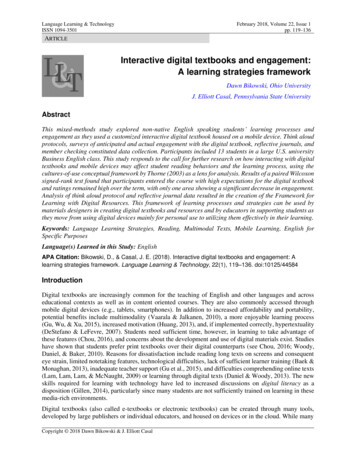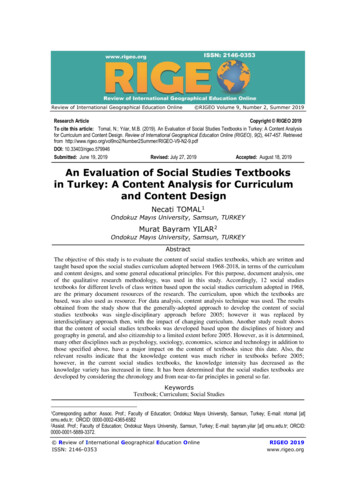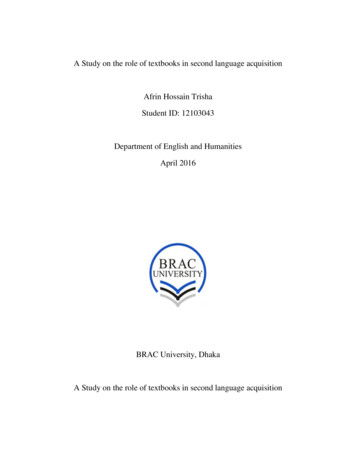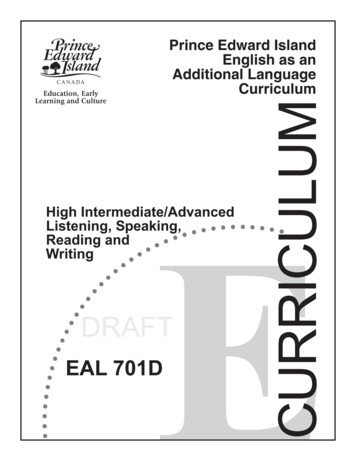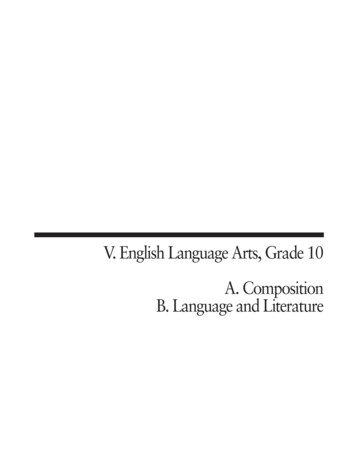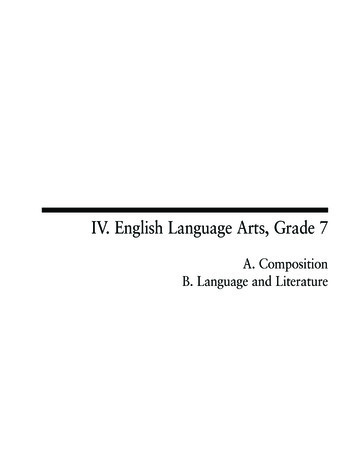
Transcription
Teachers’ perspectives on the role of textbooks in English language learning and teaching inFinlandLeena VanhaMaster’s ThesisEnglish PhilologyFaculty of HumanitiesUniversity of OuluSpring 2017
Table of contents1. Introduction12. Theoretical background32.1 Sociocultural and ecological views of language learning and teaching32.1.1 Sociocultural theory32.1.2 Ecology of language learning62.1.3 Pedagogical implications92.2 English language teaching and teaching materials112.2.1 Teaching materials122.2.2 Digital teaching materials203. Data and method234. Teacher perceptions on the role of textbooks in language learning teaching264.1 Perceived advantages of textbooks264.2 Perceived limitations of textbooks304.3 Use of other teaching materials324.4 Digital textbooks354.5 Are written skills valued over oral skills?384.6 Perceptions on learning and teaching415. Discussion486. Conclusion53References56
1. IntroductionIt can be stated that virtually every Finnish learner who has studied English at school has comeacross textbooks in their studies, some perhaps to a greater extent than others. Nevertheless,textbooks have traditionally played a significant role in English language teaching in Finland, andcontinue to do so to this day. Lähdesmäki (2004) argues that the printed book, and the textbook inparticular, still has a strong status in our culture and, thus, it has the power to define what theEnglish language and the studying of it is (p. 273). However, Hiidenmaa (2015) has pointed out thatdespite the dominant role of textbooks, there has hardly been any systematic research on them inFinland (p. 27). When it comes to teaching materials specifically in language teaching, Elomaa(2009) states that they have been systematically studied for only for a few decades (p. 32).Furthermore, the majority of the research on textbooks has concentrated on texts, i.e. they haveexamined the content of textbooks, while a smaller portion has investigated user experiences byinterviewing teachers or students (Hiidenmaa, 2015, p. 28). A particular aspect of interest both inthe Finnish and international research on textbook content seems to have been culture (see forinstance Lappalainen, 2011; Kinnunen, 2013; Shin, Eslami & Chen, 2011). On teacher attitudes, forinstance Allen (2015) has investigated Swedish teachers’ attitudes towards English languageteaching materials.Instead of focusing on analysing textbook content, the aim of this present study is to find outFinnish English teachers’ perspectives on the role of textbooks in English language teaching andlearning. The topic is worth studying because the teacher’s role is integral in teaching, and it isimportant to investigate how they perceive the role of textbooks, a significant part of languageteaching, as has already been established by previous research. The approach chosen for the studywas a sociocultural and ecological perspective to language learning and teaching, whichemphasises, for instance, that learning occurs in interaction with others, rather than inside the mindof an individual. Furthermore, meaningful contexts and the learners’ engagement are crucial inorder for learning to occur. The study was conducted as a semi-structured group interview for sixteachers. The teachers represented the levels of primary school, secondary school and uppersecondary school education. Qualitative content analysis was used to analyse the interview data.After transcribing the interview, it was examined through text analysis and categorised intodifferent themes of relevant interest.1
The thesis is divided into different sections. Section 2 will form the theoretical background of thestudy. The section will start by introducing the sociocultural and ecological perspectives oflanguage learning and teaching, before examining English language teaching and teaching materialsin-depth. Section 3 will introduce the data and the method used in the current study. Moreover,section 4 will carefully present and discuss the findings of the group interview, all the while relatingthem to the theoretical framework. In section 5, these findings will be summarised and discussedeven further. Lastly, section 6 will present the conclusion of the current study, its limitations, andpossible interests for further study in the future.2
2. Theoretical backgroundThis section forms the theoretical background of the present study. It is divided into two sections:section 2.1 presents the sociocultural and ecological views of language learning and teaching andtheir pedagogical implications, while section 2.2 discusses English language teaching and teachingmaterials.2.1 Sociocultural and ecological views of language learning and teachingThis section examines the sociocultural and ecological views of language learning and teaching. Insubsection 2.1.1 the sociocultural theory is examined, before turning to the ecology of languagelearning in subsection 2.1.2. The final section 2.1.3 discusses the implications these two notionshave on language teaching.2.1.1 Sociocultural theoryThe sociocultural theory (SCT) is largely based on the body of work of Russian psychologist L. S.Vygotsky. The fundamental idea of SCT is that human mental functioning is “a mediated processthat is organized by cultural artefacts, activities, and concepts” (Lantolf, Thorne & Poehner, 2015,p. 207). SCT maintains that while human neurobiology is required for higher mental processes (forexample voluntary memory, logic thought, learning, and attention), it is through interaction in socialand material environments that the most crucial forms of human cognitive activity develop (Lantolfet al., 2015). In other words, “the source of learning and development is found in social interactionrather than solely in the mind of an individual” (Swain, Kinnear & Steinman, 2011, p. x). Lantolf(2003) states that SCT is an exception to many theories of language learning because it sees thathumans are not bound only to their biology, but rather humans are “agents who regulate their brainsrather than the other way around” (p. 349). Schoen (2011) points out that because they are relativelynew in research terminology, there remains some ambiguity over the precise meanings of the termssociocultural theory and socioculturalism (p. 11). Next, some primary concepts of SCT – i.e.mediation, the zone of proximal development and internalisation – are discussed more in-depth.The core principles of SCT is the mediated human mind. Vygotsky argued that just as humans usematerial tools to interact with the physical world, we also use symbolic tools to “establish anindirect, or mediated, relationship between ourselves and the world” (Lantolf, 2000, p. 1). These3
symbolic tools are artefacts created by human and they can include numbers, music, art, conceptsand belief systems and, most importantly, language (Lantolf, 2000; Swain et al., 2011). On the otherhand, material tools related to language environments could be, for instance, books, pens, paper, orcomputers (Dufva, 2013a, p. 4). One of Vygotsky’s arguments was that all human mental activity ismediated by material and/or symbolical means that are culturally constructed (Swain et al., 2011).An essential form of mediation is called regulation, which can be divided into object-, other-, andself-regulation (Lantolf et al., 2015, p. 209). Object-regulation is when one uses material artefacts inthe environment, for instance a dictionary to look up words, or pen and paper to make a to-do list(p. 209). Other-regulation refers to mediation by other people and can be, for example, explicit orimplicit feedback on grammar, corrective comments, or guidance from an expert (ibid.). Finally,self-regulation is when one has “internalised external forms of mediation for the execution orcompletion of a task” (ibid.). When an individual reaches self-regulation, they can be considered aproficient user of a language (ibid.). But at times, when faced with a communicatively demandingsituation, even the most skilled speakers, including native speakers, may have to reaccess the earlierlevels of development, i.e. other- or object-regulation, by, for example, asking help from otherpeople or using an object such as a dictionary (ibid.). In sum, mediation can be understood tohappen at least on a material, mental and interpersonal level.Another central concept to SCT is the zone of proximal development (ZPD). The most commonlyreferenced definition of ZPD seems to be that is it the “difference between what a person canaccomplish when acting alone and what the same person can accomplish with support fromsomeone else and/or cultural artefacts” (Lantolf, 2000, p. 17). Ohta states that in the ZPD “a learnerperforms above his or her level of individual competence with the assistance of another;development occurs as the learner acts with increasing independence” (2000, p. 62). ZPD has beena very popular and widely used concept in educational research, which has led to misinterpretationsand conflicting views of it (Chaiklin, 2003; Swain et al., 2011). Some researchers seem to be of theopinion that the ZPD always includes interaction between an expert and a novice “in which theexpert eventually transmits an ability to the novice through social interaction” (Lantolf, 2000, p.17). While a common occurrence of ZPD would be a traditional formal teaching situation between ateacher, i.e. the expert, and a student, i.e. the novice, the expert can also be, for instance, anotherstudent or an inanimate cultural artefact (Swain et al., 2011). Some researchers have found that ZPDcan also emerge in peer interaction where there is no clear expert (Ohta, 2000, p. 55). Thus, as canbe seen, interaction plays a complex and multifaceted role that is highlighted in SCT.4
Further, Vygotsky claimed that a child’s cultural development happens on two levels: first ithappens on the social level, i.e. between people as an interpsychological category, and then on thepsychological level, i.e. as an intrapsychological category (Lantolf et al., 2015, p. 211). Movingfrom the intermental level to the intramental one occurs through the process of internalisationwhere culturally created mediational artefacts, above all language, take on a psychological function(Lantolf, 2000; Lantolf, 2003; Lantolf et al., 2015). Swain et al. (2011) describe it as the “processby which symbolic systems take on psychological status” (p. 8). At first, the activity of theindividual is regulated by other people, but, through internalisation, the individual starts to regulatetheir own mental and physical activity, or in other words “perform complex cognitive and physicalmotor functions with progressively decreasing reliance on external mediation and increasingreliance on internal mediation” (Lantolf et al., 2015, pp. 211-212; Lantolf, 2000). Ultimately, suchprocesses of internalisation lead to self-regulation and independence in learning.More specifically, internalisation is marked by private speech, i.e. talking audibly to oneself, andinner speech, i.e. silent speech to oneself (Lantolf, 2003). Private speech is “intrapersonalcommunication that mediates thinking processes” or, in other words, a tool that “helps to structureand organize our own thinking” (Swain et al., 2011, p. 36). As cognitive development proceeds,private speech evolves into inner speech, language that is condensed into pure meaning, and forexample, if somehow heard by another person, would not be comprehensible to them (Lantolf,2000, 2003). Also fundamental to internalisation is imitation. Often mistaken for simply a copyingprocess, imitation differentiates from “simple mimicry” by its “intentionality of the imitation, thereflection and examination of the results, and the subsequent revisions” (Swain et al., 2011, p. 58;Lantolf, 2003). Furthermore, what separates imitation from plain repetition and the behaviouristicinterpretations of it is its potential for transformation and the agency and intentionality it implies(Lantolf, 2003, p. 353). When imitation occurs in the ZPD with some kind of instruction, it is a“complex activity in which the novice is treated not as a repeater but as a communicative being”(Newman and Holzman, 1993, quoted in Lantolf, 2000, p. 18). However, Lantolf points out thatoften in a traditional school setting the expert, for instance, a language teacher, can demand that thenovice, for instance, a student, repeats what is being said word for word, in which case “little if anyaccount is taken of the student’s ZPD” and, though the novice might succeed in reproducing therequired model, imitation has not occurred and “such a situation is rarely if ever communicative”(2000, p. 18). What is more, Lantolf (2003) brings up that in certain circumstances, such as intraditional educational institutions, replicating exact information presented by an authority isviewed as more valuable than actual imitation that leads to transformation (p. 353). In conclusion,5
SCT emphasises the learner as a self-regulating actor and underlines the highly communicativenature of learning. The next section, section 2.1.2, discusses another perspective on languagelearning, the ecological approach, which is closely related to the sociocultural view.2.1.2 Ecology of language learningGerman biologist Ernst Haeckel invented the term ecology in the 19th century to refer to “thetotality of relationships of an organism with all other organisms with which it comes into contact”(van Lier, 2004, p. 3). In terms of linguistics, Norwegian linguist Einar Haugen definedecolinguistics or language ecology in 1972 as “the study of interactions between any givenlanguage and its environment (as quoted in Kramsch & Steffensen, 2008, p. 17). More recently inthe field of linguistics, especially professor Leo van Lier has developed the ecology of languagelearning. Van Lier states that ecological linguistics is the study of language as “relations (ofthought, action, power), rather than objects (words, sentences, rules)”, i.e. the view of language isnot material, but rather a relational one (2000, pp. 251-253). Van Lier also argues that, regardless ofwhat view of learning and teaching education professionals promote, the widely accepted factseems to be that language learning takes place uniquely in the brain and “information is receivedand subsequently processed in the brain and incorporated into mental structures providingknowledge and skills of various kinds” (2000, p. 246). What is more, van Lier states that standardscientific thinking considers activity and interaction, and in general the contexts in which learningtakes place, to relate to learning only in indirect ways (ibid.). Ecology resists these views and arguesthat “not all of cognition and learning can be explained in terms of processes that go on inside thehead” (ibid.). Furthermore, ecology emphasises that in order to form an understanding of learning,the social activity of the learner and the verbal and nonverbal interaction they participate in areintegral (ibid.). In van Lier’s words: “they do not just facilitate learning, they are learning in afundamental way” (ibid.). An ecological perspective asserts that the learner’s environment is full ofpotential meanings that slowly become available for the learner through interaction with and withinthe environment (ibid.). Hence, to consider learning is to inspect the active learner in theirenvironment, not solely what goes on in their brain (pp. 246-247). However, ecology does not denycognitive processes altogether, but rather they are connected with social processes (p. 258). VanLier summarises that “language is located in the world around us as well as in the brain” (2002, p.158). In his book (2004), he lists the ten characteristics he considers the ecological approach tohave: relations, context, patterns and systems, emergence, quality, value, critical approach,6
variability, diversity, and activity. Some of these characteristics will be dealt with in more detail inthe following paragraphs.Ecological linguistics (EL) focuses on “language as relations between people and the world”, whilelanguage learning is seen as “ways of relating more effectively to people and the world” (van Lier,2004, p. 4). A key concept is affordance, which refers to a relationship between a learner and aparticular property of their environment (van Lier, 2002; van Lier, 2004). Affordances are“possibilities for action that yield opportunities for engagement and participation”, or to put it moresimply “affordance refers to what is available to the person to do something with” (van Lier, 2004,p. 81, p. 91). It depends on the learner’s desires, actions and needs what becomes an affordance(van Lier, 2002, p. 252). Also integral in EL is context; it is “not just something that surroundslanguage, but that in fact defines language, while at the same time being defined by it” (van Lier,2004, p. 5). The context is a central focus of study in ecology, it cannot be pushed into thebackground (van Lier, 2002, p. 144). When it comes to language learning, instead of a gradual,linear acquisition, EL sees it as emergence (van Lier, 2004). Emergence is “a reorganisation ofsimple elements into a more complex system” (p. 81). So in language, “grammar emerges fromlexis, symbols emerge from tools, learning emerges from participation”, and, finally, from all thesetransformations emerges language proficiency (p. 5). In similar fashion to SCT, the ecologicalapproach regards language learning as a holistic process that takes into consideration interactionbetween people, objects, environments and the situational context.Another important notion in EL is variability. Van Lier mentions that many teachers might, out ofgood will, state that they treat all their students the same, but learners are actually different sotreating everyone equally might not be the best pedagogical practice, instead, a good teacher wouldbe able to take these differences into account (2004, p. 7). But variability, van Lier argues, can alsobe seen on higher levels, i.e. in educational systems that actually “manufacture inequalities acrossregional and socio-economic fault lines” (ibid.). Related to variability is diversity. The differencebetween the two is that while variability is about the different ways learners learn, diversityconcerns the value of having different learners in, for instance, a class (ibid.). Much like diversity iscrucial in an ecosystem, a society with diverse people may end up being healthier than ahomogeneous one (ibid.). Furthermore, similarly to the notions in teaching English as aninternational language, van Lier also argues that the language to be learnt “is presented as one thatis not one monolithic standardized code, but a collection of dialects, genres and registers” (ibid.).7
What is more, van Lier states that the assumption seems to have been that learners would beconfused when a language is presented in such a diverse way, but actually, he argues, it might bethe homogeneous and generalised presentation of a language that causes more confusion to thelearners, since it might not even exist in real life (ibid.). In keeping with the holistic approach of EL,in addition to promoting diversity among language learners, it also emphasises the importance ofpresenting the language learners a diverse view of language.Finally, ecological linguistics aims to study language and language learning “as areas of activity”,meaning that learners go through the process of learning by carrying out various activities, bythemselves, working with others, or working side by side, for instance (van Lier, 2004, p. 8). Thelearners are autonomous, i.e. “they are allowed to define the meaning of their own acts within theirsocial context”, but in EL this does not signify independence, but, rather, having “authorship overone’s actions, having the voice that speaks one’s words, and being emotionally connected to one’sactions and speech” (ibid.). In other words, language learning happens in interaction with otherswhile engaged in meaningful activities.Ecology and the previously discussed Vygotsky’s sociocultural theory are similar in many ways butalso differ in others. For instance, ecology expands on the notion of Vygotsky’s context by beingboth physical as well as social and also introduces the notion of affordance (van Lier, 2004, p. 18).On the other hand, Vygotsky’s notion that new levels of learning cannot be directly drawn fromexisting level represents an emergentist view of learning (ibid.). Another similarity between thesetheories is in their approach to learning; Vygotsky asserted that learning must be “relevant to life”,which represents an ecological approach. Another shared central concept between the two isactivity. Language is seen as activity rather than an object and, thus, language exists in the worldrather than in the head (p. 19). But with ecology, the focus moves more strongly from guidance toaction (p. 20). Van Lier states that the ecological approach attempts to bring the sociocultural theory“into a motivated, well-articulated framework that accounts for language, semiosis, activity,affordance, self and critical action” (p. 20). In sum, many features are shared in present-dayresearch on sociocultural theory, but van Lier suggests that ecology can “add significant directionand theoretical cohesion” to SCT work and move SCT forward (pp. 21-22). Indeed, in many ways,the ideas developed within SCT have been advanced by academics with an ecological approach tolanguage learning. The following section 2.1.3 discusses the implications these two approacheshave on language teaching.8
2.1.3 Pedagogical implicationsAfter examining the sociocultural theory and the ecological approach, this section aims tosummarise the implications these views have on language teaching and how they could be appliedto practice.Second language teaching has been traditionally dominated by the behaviourist approach thatfocuses on the individual, but with the rise in popularity of the sociocultural theory, the focus hasshifted to a relational view of learning and the learners’ “active role to (re)construct the context fortheir own learning” (Yoon & Kim, 2012, p. xiii). To sum up the sociocultural view of languagelearning, it sees it as a mediated process that uses different kinds of mediational means, which, in atraditional school setting, include textbooks, classroom interaction and teacher-directed talk (Dufva,2013a, p. 4). Furthermore, Dufva underlines the significance of resources in out-of-school contextsthat learners are exposed to, for instance gaming or television (ibid.). Tying the notion of mediationinto language teaching, Yoon & Kim (2012) state that the role of the teacher as a mediator is to helplearners “move from assisted to independent performance” (p. xix). They list three ways in whichmediation represents the teachers’ roles. First, the teacher mediates and supports the learners’learning “by using language as the main linguistic tool” (ibid.). To help the learner’s learningadvance from the interpsychological level to the intrapsychological one, the teacher uses form ofrepetition, expansion, or question as a mediational tool (ibid.). Secondly, the teacher promotesinteraction “by utilising language as a social and political tool”. As language does not solelycomprise of linguistic components but includes ideological concepts as well, the teacher might,even unintentionally, deliver certain messages to the learners or, through classroom activities,position them as powerful or powerless (ibid.). Furthermore, the way the teacher shares authoritywith the learners is an example of the use of language as a social and political tool, but it alsopromotes the learner’s internalisation, as the teacher implements activities as external operation,and, consequently, assists the learners to “construct meaning internally” (ibid.). Lastly, Yoon &Kim emphasise the importance of meaning-making activities through which the teacher aims toinspire and advance the learners’ learning (p. xx). In sum, in the sociocultural view of languageteaching and learning, the role of the teacher is to act as a mediator in the learning process of thelearner. The teacher can use language as a linguistic tool, to support the learner’s learning, as wellas a social and political tool to promote interaction.9
Furthermore, in terms of ecology and pedagogic practices, van Lier (2004) emphasises that thelearners should be engaged, “so that learning emanates from them, rather than being delivered tothem” (p. 222). Moreover, he states that in the classroom, “language must be richly contextualisedand semiotically interconnected with all available meaning making systems” (ibid.). Dufva (2013a)also highlights the importance of engaging learners and states that learners need to be “doing thingsin language, through language and with language” (p. 11). What is more, she argues that we shouldstart speaking about learning as “activity”, “doing”, and “participation” as this gives also learnersdifferent expectations (ibid.). Pedagogies should nourish aspects that encourage participation andfor that, there are two things that need to be taken into consideration: perception and action (p. 12).Firstly, it is important to improve learners’ ability to “notice and reflect different features of bothlanguage and learning”, and, secondly, the skills of action and participation are also crucial (ibid.).That being said, Dufva also points out that traditional grammar or the acquisition of theoreticalknowledge of language are not completely excluded in this view, as it is essentially inevitable thatthey will be a part of language curricula; instead, they are given a new position and new kinds ofactivities are created (p. 13). In other words, both van Lier and Dufva stress that learners need to beengaged instead of passively receiving information from the teacher. Furthermore, the teachingshould ideally develop the learner’s participation skills as well as the ability to notice differentproperties of both language and learning.Further, Dufva (2013a, p. 12) brings up the common misconception that language learning onlyoccurs at school and/or is led by a teacher. As already briefly mentioned earlier, she underlines theimportance of informal contexts in which learners learn and also points out that informal and formalcontexts can definitely be intertwined and mixed (ibid.). Furthermore, she asserts that languagepedagogy “could - and should” put more emphasis on how to combine school practices with out-ofschool activities (p. 11). The same sentiment is expressed by van Lier (2002) who states that“everyday knowledge is generally not ‘legitimate’ in the language classroom” (p. 158). He recountscases he has seen of students who have been failing language classes and detesting them, but whohave in their free time produced the target language in the form of, for instance, songs or rap. Inthese cases, the “‘official’ business of the language classroom” has hindered the learners’ learningand “does not connect with the existing everyday expertise” (ibid.). What is more, van Lier arguesthat learners are only required to showcase their knowledge of complex parts of syntax or distancedlexical items, and their “vernacular dexterity” is never taken advantage of or appreciated (ibid.). Insummary, based on the studies, it can be argued that school should not only insist on possibly rigidpractices and restrict learning to happen only inside the classroom and possibly solely within a10
textbook, but it should also take into consideration learners’ extramural and informal skills andknowledge in English.van Lier (2004) encourages the use of project-based curriculum as an ecological approach, butrecognises that this might sometimes be challenging, if not impossible, to put into practice (p. 222).For instance, seating arrangements might prevent project-based work and also “high stakes tests”might put pressure on the teacher to spend more time on drilling and test practice (ibid.). However,van Lier states that from his own vast experience of observation of classes, there is a starkdifference between an engaged class and “one that is just going through the passive motions ofreceiving instructions” (ibid.). Therefore, van Lier asserts that, despite possible, and often very real,difficulties and constraints, ecological ideas can be applied in any context; perception, action andcontext can be taken into consideration, and engagement can always be recognised (ibid.) What ismore, van Lier asserts that in the ecological approach the learner is “a whole person, not a grammarproduction unit” (p. 223). This includes that the learner has “meaningful things to do and say”, thatthey are taken seriously, given responsibility, and “being encouraged to tackle challenging projects,to think critically, and to take control of one’s own learning” (ibid.). The teacher’s role is to provideenough and well-timed assistance and they have to choose to set the learner’s developing skills andinterests as the most influential part of the curriculum (pp. 223-224). Ecology sees classrooms asbusy workshops filled with activity and learners “who have things they want to accomplish, andwho, with the help of teachers, fellow learners, and other sources of assistance, find the tools theyneed to achieve their goals” (p. 224). In summary, van Lier emphasises the importance of engagingstudents through, for instance, project-based activities and states that even though there can be reallife restrictions, the ecological approach, where the learner is taken into consideration as a wholeperson, can still be applied to teaching and learning under any circumstances. The next section 2.2discusses English language teaching and teaching materials.2.2 English language teaching and teaching materialsThis section discusses English language teaching and teaching materials. It sho
instance Allen (2015) has investigated Swedish teachers’ attitudes towards English language teaching materials. Instead of focusing on analysing textbook content, the aim of this present study is to find out Finnish English teachers’ perspectives on the role of textbooks in
